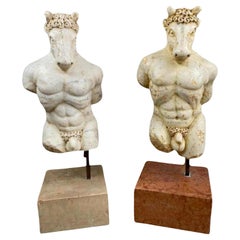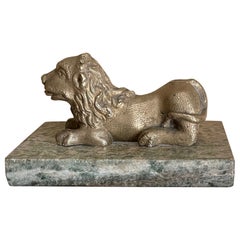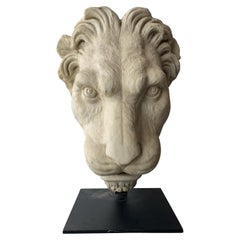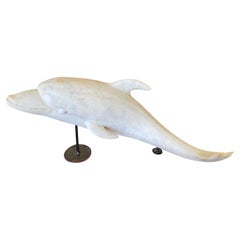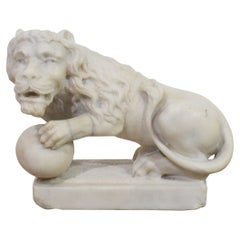Marble Animal Sculptures
14
to
2
8
6
14
14
14
3
2
1
14
116
471
77
136
188
77
9
6
47
100
3
7
13
32
9
6
Height
to
Width
to
34,231
72
56
51
35
14
11
2
2
1
1
Period: 18th Century and Earlier
Material: Marble
Pair of Amazing Italians Sculptures "Minotauro" 17th Century Carrara Marble
Located in Madrid, ES
Pair of amazing Italians Minotauro Sculptures
Minotaur, large marble figure,
Italy, 17th century,
figure with a human body and the head of a bull, baroque style, white slightly sp...
Category
17th Century Italian Baroque Antique Marble Animal Sculptures
Materials
Carrara Marble
Gilt Bronze Lion on Marble Base
Located in New York, NY
Gilt bronze lion on marble base. Antique chased gilt bronze recumbent lion on rare green speckled marble base. Italy, late 17th century.
Dimensions: Ov...
Category
Late 17th Century Italian Baroque Antique Marble Animal Sculptures
Materials
Marble, Bronze, Ormolu
Lion Marble sculpture from the 17th century
Located in Milan, IT
XVII Century
Lion
Marble, 30 x 43 x 25
The object under consideration is configured as a marble sculpture referable to the 17th century, characterized by a strong, visceral langua...
Category
17th Century Italian Antique Marble Animal Sculptures
Materials
Marble
Italian 18th C Grand Tour Roman Bronze Bust of a Horse, Specimen Marble Base
Located in West Palm Beach, FL
Italian 18th C Grand Tour Roman Bronze Bust of a Horse, Specimen Marble Base
Italy, Later 18th Century
A Italian 18th Century Grand Tour Roman Bronze Bust of a Horse, displayed on ...
Category
Late 18th Century Italian Grand Tour Antique Marble Animal Sculptures
Materials
Marble, Bronze
Griffin Head, Italy, 16th Century
Located in Bruxelles, BE
Griffin head
Italy, 16th century
On a modern metal stand
Measures: 20 x 29 x 21 cm (without the stand)
The griffin is a legendary creature with the body of a lion, the head an...
Category
16th Century Italian Renaissance Antique Marble Animal Sculptures
Materials
Marble
Roman Carrara Marble Lioness
Located in Newport Beach, CA
Magnificent hand carved Carrara marble sculpture of a lioness head from Rome. Mounted on a metal base. Base 13.75"W x 12.25"D.
Category
1650s Italian Neoclassical Antique Marble Animal Sculptures
Materials
Carrara Marble, Metal
Italian Ancient Marble Sculpture Fountain, Late 16th Century
Located in Milano, IT
Sea monster
Carrara marble mouth fountain
Italy, late 16th century
It measures 13.8 x 31.5 x 18.9 in (35 x 80 x 48 cm)
State of conservation: some small evident gaps and widespread signs of wear due to outdoor exposure. The gray marks crossing it do not come from restoration, but are rather the natural veins of the marble.
This work has some morphological characteristics typically associated with the iconography of the sea monster: an elongated muzzle, sharp teeth, protruding eyes, elongated ears, and a coiled serpent's tail.
An in-depth series of studies on artistic depictions of the sea monster attempted to verify how this symbol evolved in antiquity in the European and Mediterranean contexts and how it gradually changed its image and function over time. The iconography itself is mutable and imaginative and its history is rich with cultural and artistic exchange, as well as the overlapping of ideas. This occurred so much that it is difficult to accurately pinpoint the "types" that satisfactorily represent its various developments.
However, we can try to summarize the main figures, starting from the biblical Leviathan and the marine creature that swallowed Jonah (in the Christian version, this figure was to become a whale or a "big fish", the “ketos mega”, translation of the Hebrew “dag gadol”). Other specimens ranged from the dragons mentioned in the Iliad (which were winged and had legs) to "ketos” (also from Greek mythology), the terrifying being from whose Latinized name (“cetus”) derives the word "cetacean". See J. Boardman, “Very Like a Whale” - Classical Sea Monsters, in Monsters and Demons in the Ancient and Medieval Worlds, in Papers presented in Honor of Edith Porada, Mainz am Rhein 1987, pp. 73-84).
In Italy the monster underwent yet further variations: it can be found in Etruscan art on the front of some sarcophagi representing the companion of souls, while among the Romans we find the “Pistrice” (cited by Plinio in Naturalis Historia PLIN., Nat., II 9, 8 and by Virgilio in Eneide: VERG., Aen., III, 427), which appeared in the shape of a stylized hippocampus or a very large monstrous cetacean and evolved into a hideous being with a dragon's head and long webbed fins.
During the Middle Ages, the sea monster was the object of new transformations: at this time, it is often winged, the head is stretched like a crocodile, the front legs are often very sharp fins - sometimes real paws - until the image merges with dragons, the typical figures of medieval visionary spirituality widely found throughout Europe (on this topic and much more, see: Baltrušaitis, J., Il Medioevo fantastico. Antichità ed esotismi nell’arte gotica, Gli Adelphi 1997).
In Italy during the 15th and 16th centuries, the revival of classicism - representative of the humanistic and Renaissance periods - led to a different reading of these "creatures". Indeed, the sea monster was also to find widespread use as an isolated decorative motif, especially in numerous fountains and sculptures where dolphins or sea monsters were used as a characterizing element linked to water (on this theme see: Chet Van Duzer, Sea Monsters on Medieval and Renaissance Maps, London, The British library, 2013).
From the morphological point of view, the "sea monsters" of this period are mostly depicted as hybrid figures, in which the body of a mythological or real being (a hippocampus, a sea snake, a dolphin), is joined to a head with a rather indistinct appearance. It was usually characterized by large upright ears, an elongated snout, sharp teeth and globular, protruding eyes; a complex and indefinite figure, both from the symbolic point of view and from that of its genesis.
The work we are examining is placed as a cross between the medieval sea serpent and the Renaissance dolphin, with stylistic features which recall the snake as often used in heraldry (such as the "snake" depicted in the coat of arms of the Visconti - the lords and then dukes of Milan between 1277 and 1447 - and which, for some, may be derived from the representations of the “Pistrice” that swallowed Jonah).
In the search for sources, Renaissance cartography and in particular woodcuts should not be neglected. See for example the monsters of Olaus Magnus, from the editions of the “Historia de gentibus septentrionalibus” (“History of the peoples of the north”) and the natural histories of Conrad Gesner, Ulisse...
Category
16th Century Italian Renaissance Antique Marble Animal Sculptures
Materials
Carrara Marble
George III Blue John Panther
Located in New Orleans, LA
One of the only known sculptures rendered in Blue John to exist in the world, this extraordinary George III panther exemplifies Georgian sophistication. Georgian — and later Regency — aesthetics revived classical themes of the ancient Mediterranean and Near East. With a proud stance, gaping jaw and unyielding gaze, the stately panther closely resembles the grand ancient Roman panthers often carved from marble as trapezophoros table supports. The regal cat rests atop a plinth, also made of Blue John, with Siena and Ashford marble detailing.
The intrinsic and richly hued mineral inclusions of the Blue John replicate the textures and colors of the animal’s fur. The rare stone is a variety of natural calcium fluorite found exclusively in Derbyshire, England. It was first discovered in the early 18th century, but its mining did not being until circa 1760. Blue John was a wildly popular material in the decorative arts during the Georgian and Regency...
Category
18th Century English Neoclassical Antique Marble Animal Sculptures
Materials
Marble, Siena Marble
Large Heavy Rectangular Carved Marble Relief of the Agnus Dei 'Lamb of God'
Located in Guaynabo, PR
This is a large heavy rectangular shaped carved marble relief of the Agnus Dei. It depicts a lamb with curly hair seated over a Bible and bearing ...
Category
18th Century Italian Neoclassical Antique Marble Animal Sculptures
Materials
Marble
George III Marble and Blue John Dolphin Tazza
Located in New Orleans, LA
This important George III tazza is attributed to famed Scottish-Swedish architect Sir William Chambers. The magnificent piece features a base carved from statuary marble in the shape of a stylized dolphin, which relates to Chambers' extraordinary 18th-century architectural designs. A marvel of beauty and craftsmanship, the tazza is also inset with specimens of Derbyshire Blue John in both the plinth and bowl. Blue John is one of the most in-demand decorative stones in the world, and its inclusion in this piece elevates the tazza to a true Georgian masterpiece.
Due to its popularity, the largest veins of Blue John had disappeared by the early 19th century, and only a small amount of the stone remains today. Because of its scarcity, most examples of Blue John furniture feature only small inset veneers. By contrast, this rare tazza features not one, but two substantial specimens of the stone. It represents some of the last ornamental wares created of such grand size and proportion, though other smaller examples still grace the stately British estates of Chatsworth, Hardwick, Kedleston and Haddon, among others.
Not only does this tazza boast a highly rare material, but it was also designed by one of the most important architects and designers of the Georgian era. Sir William Chambers was a Scottish-Swedish architect based in London who was active during the reigns of Kings George II and George III. Celebrated for his combination of English Palladianism...
Category
18th Century English George III Antique Marble Animal Sculptures
Materials
Stone, Marble
Pair of Italian 18th Century White Carrara Marble Statuettes of Lions
Located in West Palm Beach, FL
A charming true pair of Italian 18th century white carrara marble statuettes of lions. Each statue is raised by an oval terr...
Category
18th Century Italian Antique Marble Animal Sculptures
Materials
Carrara Marble
Lions Pair of Sculpture Marble Italian 13th Century Romanesque
Located in BUNGAY, SUFFOLK
Rare, pair of 13th century, Romanesque, marble, recumbent lions
Recumbent lions were popular in 11th-13th century Italian architecture with pairs ...
Category
15th Century and Earlier Italian Classical Roman Antique Marble Animal Sculptures
Materials
Marble
Pair 18th C. Carved Marble Terracotta Figures Lions Sculptures Garden Statues LA
Located in West Hollywood, CA
Pair 18th C. Carved Marble Terracotta Figures Lions Sculptures Garden Statues LA . Rare large Pair of early 18th century carved marble terracotta Figures of regal lions, holding an i...
Category
Early 18th Century Italian Antique Marble Animal Sculptures
Materials
Stone, Marble
Marble Lion, Périgord, 17th Century
Located in Bruxelles, BE
Marble lion
white marble
France, probably Périgord, 17th century
Small marble lion wearing a coat of arms pendant with the engraved date, ...
Category
17th Century French Renaissance Antique Marble Animal Sculptures
Materials
Marble
Related Items
Late 17th to Early 18th Century Carved Seated Lions
Located in Los Angeles, CA
Very rare, carved Limewood Mythological Reclining Lions, probably Italian. Mounted on base.
Category
18th Century and Earlier Unknown Antique Marble Animal Sculptures
Pair of 17th c. Italian Figures on 19th c. Marble Pillars
Located in Los Angeles, CA
A Very Fine and Rare Pair of 17th c. Italian Allegorical Figures carved in Limewood. The Large Italian Marble Pillars are 19th c. The height of the Pillar only is 57.5 inches and it...
Category
18th Century and Earlier Italian Antique Marble Animal Sculptures
Materials
Marble
16th Century Stone Classical Roman Style Torso
Located in Vosselaar, BE
A wonderful 16th century draped female torso in classical style. Made in France under Italian Renaissance influence this female torso is finely sculpted with great detail to the stol...
Category
16th Century French Renaissance Antique Marble Animal Sculptures
Materials
Sandstone
Marble Sculpture of a Saint, Late 17th Century
Located in CH
A late 17th century marble sculpture of a saint, possibly Central Italian. Monogrammed on the marble base "F G F."
Category
Late 17th Century Italian Baroque Antique Marble Animal Sculptures
Materials
Marble
Spanish Sculpture "Pieta" 16th Century
Located in Madrid, ES
Spanish sculpture "Pieta"
16th century
sculpture in stone
Nossa Senhora, is represented seated securing Jesus Christ.
Measure: Height: 52 cm.
Very good condition.
Category
16th Century Spanish Gothic Antique Marble Animal Sculptures
Materials
Stone
Pair of 17th/ 18th Century Italian White Marble Baroque Ornaments
Located in Buisson, FR
Unique and very beautiful pair weathered white marble baroque ornaments. They most likely once adorned a church altar.
Original period pieces, Italy, ci...
Category
17th Century Italian Baroque Antique Marble Animal Sculptures
Materials
Marble
Italian Carrara Marble Nymph Figure
Located in Newark, England
Fine Italian Carrara marble of a Nymph. The figure stood upon a rocky plinth partially nude with a draped robe seen pouring water from a large urn as she looks on. The beautiful carv...
Category
Late 19th Century Italian Classical Greek Antique Marble Animal Sculptures
Materials
Carrara Marble
1860 Grand Tour Bronze Statue of Place Vendome Column with Napoleon, Marble Base
Located in GB
We are delighted to offer for auction this stunning antique circa 1860 Grand Tour bronze statue of Place Vendome Column with Napoleon on top in so...
Category
1860s Italian Grand Tour Antique Marble Animal Sculptures
Materials
Bronze
H 10.63 in Dm 3.43 in
Grand Tour Specimen Marbles Plaque, Italy, circa 1850
Located in Kinderhook, NY
Italian Grand Tour marble specimen plaque in original silver-giltwood frame consisting of 20 different rare and ancient marbles, including Porphyry and Jasper, inlaid into a black an...
Category
Mid-19th Century Italian Grand Tour Antique Marble Animal Sculptures
Materials
Marble
Spanish Sculpture of Saint Jerome, Late 17th Century
Located in CH
A late 17th-century Spanish wood sculpture of a penitent Saint Jerome, possibly Seville, circa 1680.
Category
17th Century Spanish Baroque Antique Marble Animal Sculptures
Materials
Wood
Grand Tour Bronze Bust of Homer, Italy, Circa:1890
Located in Alexandria, VA
This solid (except for the pedestal) hand-cast bronze is of the 8th Century BCE Greek poet, author of the Iliad & the Odyssey. Although there are no images from life of Homer, busts ...
Category
Late 19th Century Italian Grand Tour Antique Marble Animal Sculptures
Materials
Bronze
17th-18th Century Dutch Carved Oak Lion Fragment
Located in Buisson, FR
Wonderful and unique hand carved oak lion fragment. Beautiful weathered.
The Netherlands circa 1650-1750
Weathered. measurements include the wooden ped...
Category
17th Century Dutch Baroque Antique Marble Animal Sculptures
Materials
Oak
Previously Available Items
Italian 18th Century Dolphin Sculpture
Located in Atlanta, GA
A sensational 18th century sculpture of a beautiful Dolphin from Venice, Italy. Beautifully carved from Carrara marble - now resting on its iron stand. A fabulous accent piece with...
Category
18th Century Italian Antique Marble Animal Sculptures
Materials
Carrara Marble
Small 17th/ 18th Century Italian Carved White Marble Lion
Located in Buisson, FR
Amazing but also unique small hand-carved marble lion . Italy circa 1650-1750
Weathered and old repair. More photo's available on request.
Category
17th Century Italian Baroque Antique Marble Animal Sculptures
Materials
Marble
Marble Relief Depicting a Wyvern, Lombardy, Around 1380
Located in Bruxelles, BE
Marble relief depicting a wyvern
Lombardy, around 1380
Measures: 43,5 x 32 x 9 cm
On a modern metal pedestal
A wyvern is a legendary bipedal dragon with a snake body and bat wings which was quite commonly used in Italian heraldry, especially in Milan where it could have different meaning.
In this relief the wyvern is depicted raised from the ground, with open wings and a human face which indicated a noble family on the rise...
Category
15th Century and Earlier Antique Marble Animal Sculptures
Materials
Marble
Cast Bronze Sculpture of a Cat by Alfred Barye
By Alfred Barye
Located in Kenilworth, IL
Cast bronze sculpture of a seated cat, mounted on a square, marble plinth. Note the minor patination wear to the casting.
France, circa 1870.
Category
1780s French Antique Marble Animal Sculptures
Materials
Marble, Bronze
18th Century French Bronze Lion on a Rouge Antico Marble Base
Located in Stamford, CT
18th century bronze striding lion mounted on a rouge antico marble base. Lion shown growling with tail whipping.
Provenance: Roger Pringet.
Category
Late 18th Century French Louis XVI Antique Marble Animal Sculptures
Materials
Marble, Bronze
Pair of Bronze Lions after Boizot for Chenets in the Salon De La Paix, Versail
By Louis-Simon Boizot
Located in Lymington, Hampshire
A pair of bronze lions after Boizot for chenets in the Salon de la Paix, Versailles, 1786. These recumbent lions are unusually grand in scale and are raised upon the original Rouge Griotte marble bases. Each is modelled with a long nose, deeply set eyes with pronounced lids, abundant mane and the tail curled over the left hip. These bronzes are after the well-known model produced in terracotta by Louis-Simon Boizot for a pair of chenets in the Salon de la Paix, Versailles, in 1786. This pair probably circa 1786 and circa 1790.
Provenance:
The Huggins family (probably purchased by Albert Edward Huggins around 1860)
Major Tom Bird DSO, MC and bar (1918-2017). Turville Heath House.
Louis-Simon Boizot (1743-1809) was the son of a designer at the Gobelins Manufactory and rose to become a sculptor of international repute, working for both the Bourbon Royal family and the Imperial family that succeeded them. In addition to his works, both public and private, in marble and bronze, Boizot worked from 1773-1800 as director of sculpture at the Royal Sevres porcelain manufactory. He is also known to have worked on terracotta models that formed the basis of bronze and ormolu decorative objects and his work was frequently then chased by Thomire. The surviving records in the Guarde-Meuble at Versailles for the lion chenets are quite detailed. The artists Bureau, Pigal and Bourette received payment for design drawings and wax models and then Boizot received a considerably larger sum for producing
a model in terracotta. It is therefore impossible to state, with certainty, that Boizot was responsible for the original design, but the treatment of certain features of the lions, in particular the very distinctive finishing of the eyes, is echoed in a marble self-portrait by the bronzier Thomire. Rouge Griotte marble was in particular favour with the Bourbon monarchy. Examination of these bases suggests that this marble would have been quarried in the 18th century which gives additional weight to the dating of
the pieces. The fact that these valuable French works of art found their way into the home of a wealthy British entrepreneur is testament to the cordial trading relations evident in Europe following the peace of 1815.
The Huggins family owned a brewery in Golden Square (Soho), London, known as the Lion Brewhouse. As can be seen from a surviving trademark application, presumably from 1875, the particular style of the “lion couchant” on the advert bears distinct similarities to the Boizot lion.
Major Thomas Archer Bird, DSO, MC & Bar
(1918-2017) was a distinguished British soldier whose inspirational command of the anti-tank ‘S’ Company, at Outpost Snipe during the Second Battle of El Alamein, helped destroy the armoured counter-attack of General Erwin Rommel...
Category
Late 18th Century French Antique Marble Animal Sculptures
Materials
Marble, Bronze
H 14 in W 20.25 in D 0.1 in
Rare Italian Grand Tour Marble Frieze Panel of a Bear Eating Honey
Located in New York, NY
A rare and unusual Italian grand tour marble frieze panel of a bear eating honey, circa 18th/19th century.
This panel is hand-carved from sienna, rou...
Category
Late 18th Century Italian Grand Tour Antique Marble Animal Sculptures
Materials
Carrara Marble, Siena Marble
Imperial Crest Antique French Coat of Arms Lion Marble Ornament, 18th Century
Located in Sofia, BG
Large and finely carved lion and a crown marble statue in a very good condition with two large hooks for the wall. Weight more than 40 kg.
Category
18th Century French Baroque Antique Marble Animal Sculptures
Materials
Marble
H 33.47 in W 27.56 in D 11.03 in
George III Marble and Blue John Dolphin Tazza
Located in New Orleans, LA
This important George III tazza is attributed to famed Scottish-Swedish architect Sir William Chambers. The magnificent piece features a base carved from statuary marble in the shape...
Category
18th Century English George III Antique Marble Animal Sculptures
Materials
Stone, Marble
Louis XVI Marble Pedestal
Located in Essex, MA
Triangular form with three carved rams heads and festoon swags, flared base and gray marble plinth. Sold Christie's East, 1983. Ex collection William Hodgins, Boston.
Category
1790s French Louis XVI Antique Marble Animal Sculptures
Materials
Statuary Marble
Roman Antiquities Marble Sculpture of the Head of a Hare, 2nd Century AD, France
Located in Girona, Spain
Large Roman antiquities marble sculpture of the head of a hare
Exceptional monumental size
White marble
2nd century AD, France
Vintage con...
Category
15th Century and Earlier French Greco Roman Antique Marble Animal Sculptures
Materials
Marble
H 24.8 in W 13 in D 7.9 in
18th Century Italian Carved Stone Inkwell
Located in Atlanta, GA
A sensational mid-18th century inkwell from the Veneto region of Italy. Masterfully carved from marble with two eagles and a stately lion holding a shield. A wonderfully accessory fo...
Category
Mid-18th Century Italian Antique Marble Animal Sculptures
Materials
Marble
Recently Viewed
View AllMore Ways To Browse
Horse Pedestal
Mid Century Foo Dogs
Black Forest Dog
Goose Sculpture
Partridge Vintage
Turquoise Dog
Owl Sculpture Wall
Bronze Egg Sculpture
Les Clements
Bronze Elephant Signed
Huge Ceramic Sculpture
Wooden Tiger
Bronze Herons
Antique Bronze Animal Figures
Large Wooden Horses
The Wolf Sculptures
Wood Animal Statue
Bronze Hare
